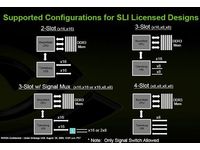Nvidia Expanding for Intel Core i7
Nvidia is furthering its support for Intel’s coming Core i7 processor line while it is preparing the announcement of its next generation of integrated graphics.
The announcement will back Nvidia’s efforts to expand offerings into Intel’s upcoming high-end desktop platform. Previously referred to as “Bloomfield”, now named Core i7. Nvidia had mentioned that is has no intentions to develop a platform specific chipset for Intel’s next-generation interconnect technology called QuickPath Interconnect (QPI). QPI is part of the Core i7 design.
On Thursday Nvidia mentioned that it will license its Scalable Link Interface (SLI) technology for the Intel Core i7 processor. The SLI technology will work along with Intel’s X58 chipset which is due to ship in the fourth quarter.
SLI allows system to be configured with more than one Nvidia graphics solution. For example, end users could build systems with two, three or even four Nvidia graphics boards.
Essentially Nvidia is offering “native” licensing of its Scalable Link Interface to partners and system builders. Native licensing does not require the specific use of the Nvidia nForce 200 bridging chip, thus increasing the graphics support range on Core i7 based systems.
As of current, Nvidia has only ever offered nForce 200. nForce 200 is basically specialized PCI Express bridge chip that is the under workings of SLI. This has been the only solution. Nvidia plans to continue its nForce 200 offering going forward. The main distinction between native and nForce 200 is that native SLI allows for more common configurations.
It is rumored that Nvidia was losing ground to AMD-ATI by not offering a solution that appeals more to system builders and end users.
Get Tom's Hardware's best news and in-depth reviews, straight to your inbox.
Nvidia also plans to announce a new high-performance motherboard based integrated GPU in the coming weeks. This will be a follow-on to its GeForce 8200 mobile GPU solution. The upcoming mobile GPU will be complete with the Intel G45 integrated graphics chipset.
-
apache_lives Nvidia quitting the chipset business anyone? Thank god for this Intel/Nvidia deal, only chipsets i trust are Intels (although ATI/AMD's chipsets seem ok for AMD based systems)Reply
On the other hand i will not pay a premium price for dual cards when i can get an ATI based rig and actually beat the performance on a near standard motherboard (depending on the PCIe lanes etc) -
estreetguy So let me get this straight - if Nvidia is now going to license SLI technology, native based, that means board manufacturers will now be able to offer SLI capable boards without the nForce 200 bridge chip, provided the boards are i7 platform.Reply
Thats seriously cool IMO. Going to give AMD-ATI another run for their money. Maybe this is why Nvidia had no plans to release a new GPU in competition with ATI's latest. There is obviously some ground and dollars to be made here. -
giovanni86 Sticking it out with the 790i ultra boards. I hope Nvidia later down the road at least gets a board out in the market. I for one do not trust or like Intel based boards.Reply -
I was an AMD / Nvidia fan boy. I swore i would never buy intel anything. My intel boards may not be the best over clockers, but by far the most stable. I have never been disappointed with Intel boards, but i have been disappointed with alot of different Nvidia based boards.Reply
-
invlem Years back VIA was the way to go for a stable, then they just completely tanked at one point when the early Athlon XP's came out (Athlon 1600-2000). I don't know what happened, since then though its been Intel chipsets for me and I cant complain, they're just plain stable.Reply -
Niva Does this mean that Intel chipset will support both SLI and Crossfire natively now? It has been known for a while that only legal issues are preventing this from happening, look at the Skulltrail platform for example.Reply
Anyways, good for Intel chipsets! It's nice to have more choices. -
neodude007 I have had my 680i Nvidia board for a while. I have 2 8800GT cards overclocked and my E8400 overclocked near 4GHz... who says Nvidia boards are unstable? You need to stoofoo....cuz mine doesn't randomly crash sooooo I assume its um... stable?Reply -
apache_lives NeoDude007I have had my 680i Nvidia board for a while. I have 2 8800GT cards overclocked and my E8400 overclocked near 4GHz... who says Nvidia boards are unstable? You need to stoofoo....cuz mine doesn't randomly crash sooooo I assume its um... stable?Reply
I think when people "hate intel boards" its either Intel branded Intel motherboards (stable, yet totally locked down oc wise mostly) or its because cheap a$$ companies like ECS/PCCHIPS/EliteGroup and MSI etc make such junk products - nvidia makes the high end boards them selves for a reason! (680/7x0 etc), but for total stability/compatibility etc Intel knows best and they should - they have been doing this wayyyyy longer then anyone else. -
jaragon13 Giovanni86Sticking it out with the 790i ultra boards. I hope Nvidia later down the road at least gets a board out in the market. I for one do not trust or like Intel based boards.790I is not superior in any way...Intel and AMD make the best chipsets,hands down.Reply
